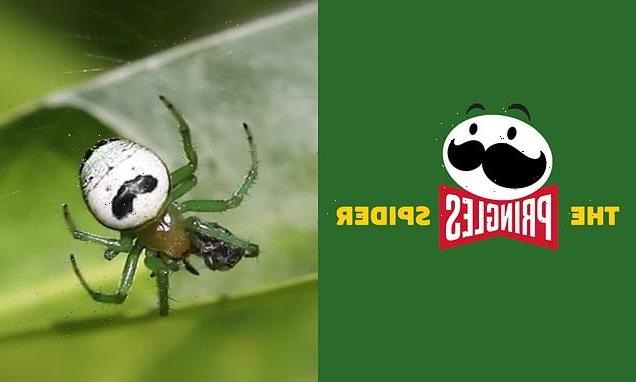
Potato chip company Pringles petitions to have the Kidney Garden Spider name changed because it resembles the firm’s mustachioed mascot
- The kidney garden spider has a round, white body with black accents
- The black appears to form a face with a thick mustache
- Pringles says the pattern looks just like its mascot Mr P
- The chip company is petitioning the International Society of Arachnology and nine other groups to have its common named changed to Pringles the Spider
The kidney garden spider features a white body with black accents that form a the pattern of a face with a mustache, and according to Pringles, the design is a spitting image of its mascot.
The American chip company is petitioning to have the spider’s common name changed to the Pringles Spider, not its official name that was established in 1886.
Pringles launched a petition to the International Society of Arachnology and nine other similar groups on Change.org with the hopes of making its claim on the spider – and it has received more than 800 signatures as of Wednesday morning.
Mauricio Jenkins, US marketing lead for Pringles, said in a statement: ‘In 1968 the world was introduced to the iconic Pringles can and logo, but little did we know there was a creature amongst us who was unknowingly spreading the Pringles love.’
Scroll down for videos
The kidney garden spider features a white body with black accents that form a the pattern of a face with a mustache, and according to Pringles, the design is a spitting image of its mascot
The Kidney Garden spider is native to Southeast Asia and are very small – females are only about one quarter of an inch long and males are roughly half that size.
They are common in gardens and low vegetation and typically build their webs in bushes.
They have a globular-shaped abdomen that is covered in fine hair and although the white and black pattern on the surface varies, most appear to show a face with a mustache.
‘If you’re thinking ‘OMG that spider looks exactly like the Pringles® logo’… We couldn’t agree more. It’s green, has 8 legs and a Pringles logo on its back,’ reads Pringles petition. ‘Which is why Pringles is on a mission to get this spider officially recognized as the Pringles Spider.’
The American chip company is petitioning to have the spider’s common name changed to the Pringles Spider, not its official name that was established in 1886
However, it is unlikely the spider’s name will be changed – but Pringles said it will give fans free chips if it does.
Naming a spider after a potato chip brand may sound bizarre, but scientists have long named arachnids after famous people – and even cartoon characters.
A peacock spider was named Nemo after the clownfish in Pixar’s Finding Nemo franchise.
Maratus nemo, which is only about the size of a grain of rice at just over 4mm in length, was discovered by a citizen scientist in South Australia.
The name nemo was chosen because of the spiders iridescent orange and white stripes, which scientists say are used to attract a mate during courtship.
Maratus nemo is described in a new paper published in Evolutionary Systematics, authored by Australian spider enthusiast Joseph Schubert.
Naming a spider after a potato chip brand may sound bizarre, but scientists have long named arachnids after famous people – and even cartoon characters. A peacock spider was named Nemo after the clownfish in Pixar’s Finding Nemo franchise
Pictured is the cartoon character Nemo
‘It has a really vibrant orange face with white stripes on it, which kind of looks like a clown fish, so I thought Nemo would be a really suitable name for it,’ said Schubert, a 23-year-old arachnologist at Museums Victoria.
‘Curiously, Maratus nemo was found in an ephemeral wetland complex on marshy vegetation in shallow water.
‘No other species of Maratus are known to occupy such habitats.’
The tiny Peacock spiders, or Maratus spiders, are native to Australia and are internet sensations for their elaborate courtship dances.
During the species’ unique ‘dancing’ courtship, the male elevates a single leg, slowly waving it in a partially flexed position.
As the female approaches, the male raises and more rapidly waves both legs.
Maratus nemo was discovered by Sheryl Holliday, a South Australian citizen scientist and an ecological field officer for Nature Glenelg Trust.
The species appears to be quite widespread, according to Holliday.
‘I’ve seen about 40 individuals all up at three different locations… I’m sure there would be more in the south east of South Australia and in western Victoria as well,’ she said.
Source: Read Full Article




